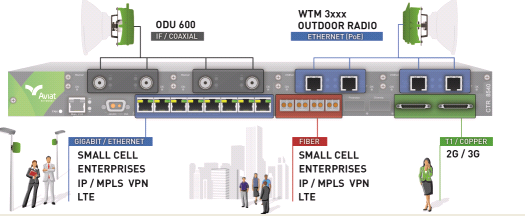There are very few areas in mobility that are getting more attention than that of backhaul. The reasons are simple. Backhaul of mobile traffic is the largest cost component of providing service. As such, bending the cost curve has taken on a level of urgency. This is because of such things as small cell and 4G LTE deployments, the migration to all-IP networking and the need to better manage the explosion traffic operators are experiencing and that they know will only exponentially increase sooner, rather than later.
With the elimination of cost and pain points as a priority design criteria, Santa Clara-based Aviat Networks, one the leaders in microwave networking solutions with 750,000 systems installed globally, has introduced the Aviat CTR 8000 microwave networking platform. It commands attention because the CTR 8540 microwave router member of this new microwave platform family includes a fully featured IP/MPLS router.
This is a significant industry milestone. The inclusion of purpose-built routing creates an all-in-one box that combines microwave transport, Layer 2 Carrier Ethernet and Layer 3 IP/MPLS routing. It holds out the possibilities for not only bending the cost curve but also making mobile networks more robust in terms of manageability and providing improved quality of service (QoS) and ultimately improved quality of Experience (QoE) as well.
“As a microwave platform, CTR 8540 is the most compact and highly integrated solution available,” explained Michael Pangia, president and CEO, Aviat Networks. “It combines the functionality of five separate devices and supports 50 percent more radio interfaces and twice as many Gigabit Ethernet ports as any other microwave solution, as well as delivers up to 4 Gbps of aggregate capacity per link. This places CTR at the head of the microwave market, even before you add the L3 capability.”
A “Swiss Army knife” to transform backhaul infrastructure
CTR has an open, software-based architecture, so it can be deployed now as a Layer 2 microwave solution, with IP/MPLS functionality capable of being added when required via a simple software upgrade. The CTR has been architected to leverage MPLS traffic engineering to offer SDN (software-defined networking) backhaul resource management and optimization. This allows for a phased migration path to SDN architecture over time, while eliminating the need for separate SDH and SONET boxes.
In discussing the CTR with Shaun McFall, chief marketing officer at Aviat, he noted that, “There is little doubt that microwave is going to be a major component of mobile backhaul in congested areas, and particularly in developing countries where fiber is not available and is unlikely to be.” He added, “As Mobile networks go increasingly all-IP and bandwidth requirements increase, the need for upgrading the backhaul network becomes and imperative, and having a router that is built from the ground up that understands the unique attributes of RF will be essential. It is why we believe the CTR because of its ability to take multiple feeds and efficiently aggregate and route traffic is so important to operators going forward.”
Where CTR fits in a mobile network can be seen in the graphic below.

Source: Aviat Networks
Along with the announcement of the CTR was recognition by an early adopter. “The Aviat CTR microwave router is a great foundation for a long-term partnership with our nationwide LTE operator,” says Mikhail Petrov, CEO, Osnova Telecom of the Russian Federation. “It meets the high standards of quality and total cost of ownership that we demand from our partner’s solutions.”
As McFall noted, “Adding router into device prevents investment in an external router. Plus, we know from years of experience that the typical router does not understand peculiarities of RF which is why the design of the CTR is so unique.” He added that, microwave is now 20 percent of global backhaul. It is likely to grow over time especially in the developing world where it is the best option for transport and with the new capabilities of CTR we have positioned it as the best option for tying things together. And, there is the added benefit of being able to reuse existing radios which as traffic increases have in many cases become hubs themselves.”
With the priority in mobile being smaller, cheaper and faster, having a single box that can take multiple high-speed microwave links from a single unit that not only aggregates traffic but efficiently routes it, is something new and clearly something that raises the bar in the rapidly evolving backhaul market.
Edited by
Stefania Viscusi  QUICK LINKS
QUICK LINKS